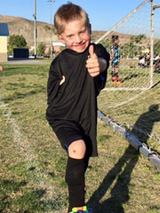Chylothorax: Tayvin’s Story
Chylothorax: Tayvin’s Story

Tayvin’s lymphatic system was leaking fluid into his chest following heart surgery when he was 4. He flew from California to Philadelphia for an innovative interventional procedure to seal the leaks. Within weeks, he was back to his favorite activities: swimming, snowboarding and motorcycle riding with his dad.
During a routine ultrasound, doctors discovered that Kambria and Trevor’s unborn child had hypoplastic right heart syndrome, a rare heart defect, and only one arm. When Tayvin was born, cardiac surgeons were in the delivery room, prepared to rush him into emergency surgery for breathing problems typically associated with hypoplastic right heart syndrome.
But right from birth, Tayvin started a pattern of defying expectations. “He came out pink, not blue,” remembers Kambria. Tayvin was breathing and didn’t require any immediate surgery.
Tayvin did need a series of heart operations to correct the hypoplastic right heart syndrome though, and each procedure was followed by another problem — lymphatic leaks. This complication is what eventually brought the family from their home in California to Children’s Hospital of Philadelphia (CHOP).
Lymphatic system problems
Tayvin had his first surgery at 2 months old to improve the blood flow from his heart to his lungs (a procedure called pulmonary artery banding). The surgery was successful, but resulted in chylothorax, a condition in which fluid leaks from the lymphatic system and collects around the lungs. Although rare, injuries to the central lymphatic system during surgery sometimes occur. If untreated, chylothorax can cause breathing problems because pressure is put on the lungs. If too much lymphatic fluid is lost, the body’s ability to fight disease can be weakened.
Tayvin was put on a special low-fat formula to reduce the production of lymphatic fluid and the leakage subsided over the next few weeks. After two months, he was able to go back on normal baby formula.
At six months old, Tayvin had his second heart procedure to improve the circulation of oxygen to the upper parts of the body. Again, the surgery went well but left Tayvin with chylothorax. He was put on low-fat formula once more, and again the leakage resolved after a few weeks.
More about chylothorax
Chylothorax occurs when lymphatic fluid leaks into the space between the lung and chest wall, causing severe cough, chest pain, and difficulty breathing.
When Tayvin was 4 years old, he underwent his third procedure to improve the flow of oxygen to the lower part of his body. The surgery went well, and he seemed to be recovering quickly at first. He was up and walking within 24 hours. But once again, he developed chylothorax. This time, his case was more severe. A large amount of thoracic fluid was leaking into his chest and draining out through the tube that had been placed to remove blood and other fluids following the surgery.
Once again, Tayvin’s doctors put him on a low-fat diet, but he was eating solid foods now and wasn’t happy about the restrictions. “He’s an eater,” Kambria says. “He was hungry. He wanted to eat everything.”
After three days, there was no change in the amount of lymphatic fluid draining from his chest. His doctors performed a second operation, thoracic duct ligation, in an attempt to close the leak. When that failed, they put him on total parenteral nutrition (TPN). Tayvin would get all his nutrition through an IV feed, and he wasn’t allowed to eat anything by mouth.
“He was miserable,” Kambria remembers. “It’s hard, at 4, to tell him he can’t eat anything.”
Tayvin’s fifth birthday passed at the hospital in California, where he was still on TPN four weeks after his surgery. “I didn’t even tell him it was his birthday,” Kambria says. “He couldn’t eat, so he wouldn’t have been able to celebrate.”
A cross-country flight
One of Tayvin’s doctors suggested that the family seek care from Children’s Hospital of Philadelphia (CHOP), where a new procedure had been developed to repair leaks in children’s lymphatic systems. That was the first time Kambria and Trevor had heard of CHOP’s experience with lymphatic leaks, and they quickly did some research. Everything they found seemed promising. Days later, the family flew to Philadelphia.
Upon arrival, they met with Yoav Dori, MD, a pediatric cardiologist at CHOP, who directs the Jill and Mark Fishman Center for Lymphatic Disorders. “Everyone was so helpful and sweet,” says Kambria.
“Dr. Dori told us, 'We're going to find the leak, fix it, and you'll go home in a week.'”
He also told Tayvin he could eat since the TPN was ineffective, so the family was able to throw a belated fifth birthday celebration for Tayvin. The Child Life Services team, a group that helps patients through therapeutic play, provided ice cream cake, balloons and presents.
A breakthrough intervention
A few days later, it was time for Tayvin’s procedure. Dr. Dori used dynamic contrast MR lymphangiography (DCMRL), an advanced imaging test, to confirm the location of Tayvin’s leaks. They then performed a procedure called thoracic duct embolization to stop the flow of lymph that was leaking into his lungs.
Tayvin quickly showed a dramatic improvement. Before the procedure, Tayvin was draining 120 cc of milky lymphatic fluid. Within days after his operation, the levels dropped down to 10 cc. After a week, the drain was removed, and he was able to go home.
“Dr. Dori and his team are wonderful,” says Kambria.
Opening new doors

Tayvin has surprised and amazed his parents throughout his entire life. Though he was born with only one arm and a problematic heart, he taught himself to swim when he was 3. That same year he got his first bicycle, and insisted on riding it out of the store with no training wheels.
And now, the surgery has opened up new doors for Tayvin. Before his procedures, activities with high altitudes had been off limits because of his heart problems and related complications. But in the winter of 2017, Tayvin was able to go snowboarding in the mountains for the first time. He took to it like a natural. After two mornings of lessons, he was on the big slopes with his family.
Before his operation, Tayvin also wasn’t allow to fly in standard commercial airplanes (he was transported from California to Philadelphia by a special medical airplane). He now can, allowing the family to more easily travel. Most recently Tayvin has taken up motorcycling, and rides with his father at a track.
He’s a joy and an inspiration to his parents. “He’s funny, smart and athletic,” says Kambria.
“He's taught us about gratitude and patience and drive. He's my son who has conquered all and who will continue to conquer all.”

Make a gift
Stories like these and breakthrough discoveries are only made possible through donations. Help the Cardiac Center fuel innovative care and pioneering treatments.